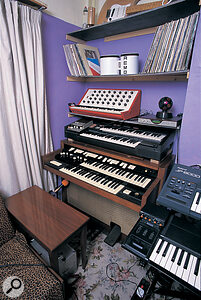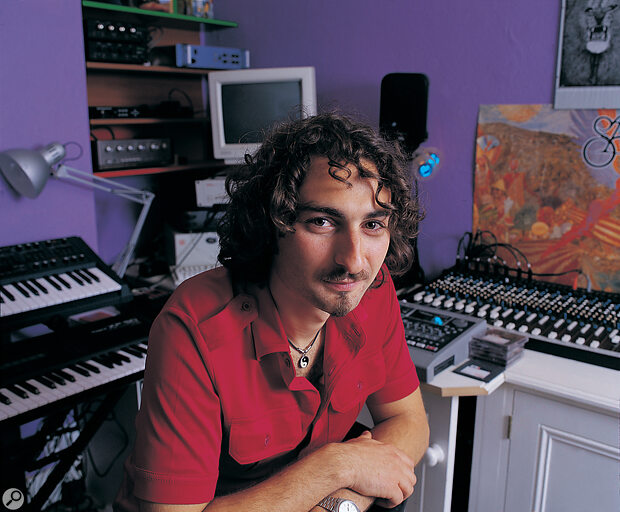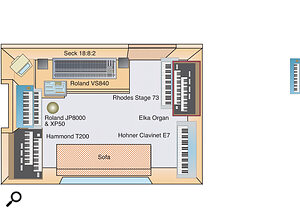Bedroom studios are regularly featured in our Readerzone pages and, in that respect, Simon Rinaldo's setup in the upstairs front room of his terraced house is nothing out of the ordinary. But not many musicians manage to find space for a full recording system, a three‑seater sofa, plus an impressive collection of vintage keyboards.
"My studio used to be in the small bedroom when I first moved into the house but I get this thing I call 'kit lust' every pay cheque. When it got the better of me I purchased a Hammond tonewheel organ, then my girlfriend had no option but to let me use the largest room, which was our bedroom at the time!"
By Simon's own admission, his recording hardware is modest and minimal, but his priority in recent years has been to spend his money on instruments, or more specifically on vintage keyboards. The room now contains a Fender Rhodes Stage 73, Hammond T200 tonewheel organ, Hohner Clavinet E7, Elka stage organ plus Simon's concessions to digital technology; a Roland JP8000 and Roland XP50 workstation. Everything is mixed and recorded onto a Roland VS840 digital studio. An ageing PC is used for sequencing duties only, and sampling is left to an Akai S2000. A Seck 18:8:2 desk is largely used as a submixer.
Simon explains his thinking behind the setup. "I like to get my sounds right before they're recorded. I've got this idea in my head of what I want and it's based around all the old sounds, so I'm getting the old kit. I've tried to get those sounds from other things but it's impossible, although when I'm playing live I use the Roland XP50 for a lot of the Rhodes stuff because the Vintage expansion board has a really good Rhodes. Most of the time you can't tell the difference through a PA system." For other practical reasons (the Hammond T200 took four people to carry it up the stairs) Simon uses a Hammond XM1 module live, but studio recordings are done using the original instruments.
Keyboard Crazy
Simon's search for vintage sounds has made him into a bargain hunter. He buys many of his keyboards cheap and in poor condition and then renovates them. The splendidly revamped Elka keyboard proved to be a particularly good purchase. "I don't know what model the Elka is. It's a cross between a Vox Continental and a Farfisa Compact Duo — very useable. Just like the Hammond, it has a full range of drawbars, a pedal board, percussion, and its got a switch that adds keyclick.
"I bought it for £40 off this old guy who used to play church music. It was in a bit of a state. You had to give it a kick to get it to go. It's one of the first transistor‑based things they ever did, I should think. There were lots of different boards inside and most of them were a bit dodgy with dry joints — it looked terrible. I stripped it down and re‑soldered the joints. I also re‑built the pedal board. A few wires had come out of place, and it needed new switches. It had been covered in black vinyl which was all ripped so I reholstered it in red suede‑type material. It's now flightcased with handles and everything. The sound lacked a bit of 'oomph', so I now run it through a Hughes & Kettner Rotosphere for the Leslie effect. The Rotosphere's got a valve preamp which really warms it up."
Simon's Hohner Clavinet E7 was another bargain, bought for just £80. "Each key has stick‑on rubber pads, which hit the string like a piano hammer, and a few of those were worn on the keys which get used most. They eventually wear a groove where the string digs in, which then hooks on the string and pulls it up so you get this awful banging noise as you release the key. It's a common problem. I could only get hold of the rubber pads from Australia, which wasn't very convenient, so the only thing I could do was to file the groove out. Fortunately it worked.
"A friend adjusted all the pickups inside so everything was a bit more equal in sound. The pickups can be raised or lowered, the same as on a guitar; basically it is a guitar inside but with a lot more strings. You can have all the pickups selected or different combinations, the same as on a Strat, and they adjust the tone. I plug that through a Cry Baby Wah."
The aforementioned Hammond T200 is another recent vintage aquisition, and comes complete with a built‑in Leslie speaker. "It's not a B3, but it is a tonewheel and has a lovely sound. I picked that up for £250. I think it needs a total overhaul because now and again one of the drawbars will cut out, but it has been looked after over the years. It's even got the original little oil containers inside. You just top it up with oil and it filters through to the bearings, like in a car."
Perhaps the most unique instrument in Simon's studio is his own custom synth (see 'Building A Custom Synth' box) sporting three oscillators, a VCO, two LFOs, a VCF and a VCA, plus controls for noise, glide, shape, tune, keyfollow, range, rate, cutoff, resonance, envelope amount, attack, decay, sustain and release. "I built that one with a friend of mine called Adrian Dolente. Its similar to a Minimoog and some of the circuits are based on Moog and Oberheim, but they're all modified and use their own components. It's not perfect, now and again it goes out of tune but no more than a guitar. You have to be careful with the speakers you're using because it just gives as much as it wants."
The Setup
 The newly installed Hammond and miked‑up Leslie speaker.
The newly installed Hammond and miked‑up Leslie speaker.
Keyboards and vintage synths aside, the studio has a small core of recording hardware centred around a Roland VS840 and Seck 18:8:2 desk. Simon explains how things are arranged. "Everything goes into the Seck desk. It's just an analogue desk but very quiet. It has 18 channels and eight busses so I can send groups out to the Roland VS840.
"Sequencing is done on my PC using Cubase VST. The VS840 is the sync master. The PC can't always keep up so you have to stop occasionally and move some MIDI. My PC is running at 66MHz so the next thing is a PC that can really do the job. The Roland XP50 is my master keyboard which is basically a JV1080 inside but I've expanded it three times with '60s and '70s keyboards, Vintage synth and dance boards to provide Rhodes, Wurlitzer, Clavinets and Mellotron sounds.
"I arranged the room with the speakers either side of the Seck and VS840. The sofa is placed against the opposite wall for listening back to tracks. The most important thing is to have the desk and VS840 between the speakers so when you're working you're sitting in the right place. The Roland XP50 has to be near the PC and all the digital and MIDI stuff, because I work with it all together.
"Sampling is handled by the Akai S2000 and the Zoom samplers. I much prefer to record real playing as opposed to sequencing my music. Sequencing is great for some things but lacks feel and can lack dynamics. I hate sounds which try to sound like real instruments, you can always tell. You'll never catch me playing a brass preset. I would rather record a drummer than spend hours programming. I have been known to use the Roland TD5 in the studio and re‑sample each drum, but there is no replacement for real drums."
Simon chose the VS840 rather than Cubase VST for hard disk recording and mixing, expecting its operating system to suit his working method developed from using reel‑to‑reel recorders. "One of the bands I was in used to own a Revox B77. The Revox is my favourite, but it's a pain in the arse splicing the tapes. The quality is definitely better than any digital recorder I've used, but there again, my hard disk recorder never goes wrong. It's so easy to use that I don't even have to think about it — even if I'm tired I can still work."
"When I bought the VS840 I thought it would be an asset with the removable media, but I need more disk space — 100Mb is not enough. Now I'm looking at getting a Roland VS1680 or Akai DPS16 because I'm running out of tracks and I'm having to compromise the music by bouncing down. I like to keep everything separate so I can change stuff afterwards."
Simon's studio isn't large enough to accommodate a live band or even a drum kit, so the compact all‑in‑one VS840 makes a useful portable live recorder. "I don't always use live drums. I either record the whole thing live in a rehearsal studio with keyboards or I record passages and sample them, then start editing on the sequencer. Standard recording setup would be a long multicore cable going to the live room where I have the option of having 18 mics on the 18 channels of the Seck. The Seck inputs would be routed out of the eight groups into the hard disk recorder. I usually keep the kick and the snare on their own then merge some of the other drums. Normally, it's just six mics out through four groups. In the VS840 it would be mixed down to a stereo pair for effects and compression. "To get the right tempo I generally send a click from the VS840 to the drummer's headphones so that he can keep perfectly in time with the the MIDI clock. Then you can work on sequenced stuff afterwards."
The Right Effect
The VS840's effects board provides many of the effects used in Simon's recordings, but there are still a few external boxes which he regularly uses. A favourite is the Echoman delay unit, used largely for creating dub effects. "I usually run the snare drum through the Echoman. It's all analogue circuitry. It actually produces white noise on its own and this can be used to create feedback and delay. It's a fault which is useable — you don't even need to plug anything into it!"
Preferring to record most things dry, Simon generally adds the Echoman effect after recording. "You can take the signal out of the VS840's monitor outs, straight through the Echoman then back into one of the VS840's analogue inputs. It's quite a crude way but it works. I've used it on a couple of tracks when I'm working on drums, adjusting in real time by bringing the effect volume in and out."
For recording, line‑in signals are taken from the Clavinet, Rhodes and Elka, with only the Leslie speaker of the Hammond requiring miking. "I use just one mic for the Leslie. I like one mic. It's a personal thing," explains Simon. "The Rhodes is my favourite bit of kit. I record it down flat, then mess around with it afterwards. The Suitcase Rhodes had tremolo but this is a Stage Rhodes, so it doesn't have any effects at all. Normally I add tremolo digitally. Sometimes I make it into a stereo effect so it pans from left to right. Reverb is another digital effect I use. It's not very playable to add echo at the end of each note but at the end of a passage you can add a bit of Echoman."
Many of Simon's musical efforts are directed towards his band Origin Red, a jazz‑rock, funk, blues and dub outfit who are currently promoting their music through (www.peoplesound.com). Simon also has a solo project on the go. "I'm currently producing my own album using various local musicians to play drums, bass and guitar. The album is going to be based on the funky vintage‑keyboard sound. I don't want it to be too pristine. I'm hoping to record a lot of it live. I like that raw style of recording."
Simon's studio, as it stands, represents a major step towards his childhood dream of owning a recording studio, although it's currently without soundproofing and has neighbours on either side. "The old lady next door lives at the other end of the house and these are quite long houses with thick walls so there's no problem. And the guy on the other side is really tolerant, but I'm always aware of the noise. It's quite a quiet road at night, but now and again you get a motorbike going by or a dog barking. I need more space and a live room that's soundproofed, then I could possibly look at producing full time. I'd like to produce other people too. A lot of the time I produce people who come to me for a demo. I've recorded bands in other studios with my equipment but it takes too long to set up and too much messing about. I like the idea of having the studio in the house or near the house. At the moment this is just a dream, but who knows what will happen in the future."
Main Equipment
 The homemade synth was built from a combination of standard components and spare parts from a broken Lowrey organ.
The homemade synth was built from a combination of standard components and spare parts from a broken Lowrey organ.
- Roland VS840 digital multitrack.
- Seck 18:8:2 mixer.
- Akai S2000 sampler.
- Roland XP50 workstation.
- Roland JP8000 synthesizer.
- Elka organ.
- Fender Rhodes Stage 73.
- Hohner Clavinet E7.
Simon's Studio Gear
- Fender Rhodes Stage 73.
- Hammond T200 tonewheel organ with Leslie speaker.
- Hohner Clavinet E7.
- Elka stage organ.
- Homemade analogue synthesizer.
- Hammond XM1 and XM1c Drawbar organ module.
- Roland XP50 workstation with Vintage Synth, '60s & '70s keys and dance expansion boards.
- Roland JP8000 analogue modelling synthesizer.
- Technics EX30 organ.
- Akai S2000 sampler (18Mb).
- Red Sound Dark Star.
- Zoom ST224.
- Roland TD5 digital drum kit.
- Alesis NanoBass.
- Mellos analogue echo unit.
- Hughes & Kettner Rotosphere Leslie Simulator.
- Cry Baby Wah‑wah.
- Peavey Pro‑Fex II digital effects unit.
- Echoman analogue echo unit.
- Seck 18:8:2 mixing desk.
- Roland VS840 workstation.
- PC Running Cubase VST.
- JBL monitors.
- Philips CDR760.
- Technics amp.
- Goodmans CD rigged up to sampler.
- Trio 1970s stereo amp.
- Behringer 8:2 desk.
- 1970s Technics cassette recorder.
- AKG 190E.
- Peavey PVI.
- Pressure Zone mic.
- Beyerdynamic vocal mic.
- Electric guitar (Strat copy).
- Carlsbro keyboard amp.
- Remo congas.
- African finger piano.
Building A Custom Synth
 Elka Stage Organ (top left), Fender Rhodes Stage 73 (bottom left), Hohner Clavinet E7 (far right).
Elka Stage Organ (top left), Fender Rhodes Stage 73 (bottom left), Hohner Clavinet E7 (far right).Sitting on a shelf, just above the Hammond, in Simon's studio is the homemade Moog‑style synthesizer, designed with friend Adrian Dolente. Simon explains how the project developed. "Adrian's a bit of an electronics whizz. He originally built a little one‑oscillator analogue‑synth box on his own. I was very impressed with it, but I thought he could improve it by building a keyboard into it and giving it three oscillators. We designed this thing around the Minimoog.
"Some of the circuits were from the Internet, but they didn't actually work at first. Whoever drew the circuit didn't do a very good job, so it needed a bit of modification. I bought the components from CPC and RS — they're all standard components that you can buy from any electronics catalogue. The keyboard came from an old Lowrey organ and a few of the transistors came from that as well. I built the box and all of the panels myself and covered them with the same red material I used on the Elka.
"Some of the rotary knobs need adjusting; sometimes you turn them a little and they move lots and vice versa. However, the synth now stays more in tune than a lot of Moogs I've played. It takes hours to tune because you've got to get each oscillator on each octave in tune. There are three very small pots, adjustable by screwdriver, in the top left corner, and that's the CV scale for each oscillator. We also fitted heat sinks on the back, otherwise it goes out of tune as it heats up. I've got one front‑panel knob spare so I'd like to add a few things, including a phaser. I've never considered marketing it. It's just something I've built for myself."



